Strength Reduction Due to Acid Attack in Cement Mortar Containing Waste Eggshell and Glass: A Machine Learning-Based Modeling Study
Abstract
1. Introduction
2. Research Methodology
2.1. Data
2.2. Machine Learning Algorithms
2.2.1. Artificial Neural Network
2.2.2. K-Nearest Neighbors
2.2.3. Linear Regression
2.3. Validation of Model
2.4. RreliefF Analysis
3. Results
3.1. ANN Model Results
3.2. KNN Model Results
3.3. LR Model Results
3.4. Validation Results
3.5. Results of RreliefF Analysis
4. Discussions
5. Conclusions
- A strong correlation was seen between the developed ML models and the results obtained from testing, signifying their probable applicability in estimating the fraction loss in CS of cement-based composites treated with ESP and RGP.
- The ANN model was considered more favorable than the KNN and LR models because of its higher accuracy level, as evidenced by the R2 values (0.87 for ANN, 0.81 for KNN, and 0.78 for LR).
- The evaluation of errors, such as MSE, MAE, and RMSE, suggested that the ANN model prediction capabilities were more substantial than the KNN and LR models. The ANN model exhibits MSE, MAE, and RMSE values of 6.51%, 1.32%, and 1.63%, respectively.
- The feature importance graph suggested that the concentration of ESP and RGP, as well as the percentage of cement, greatly influenced the decline in CS subjected to acid-attack tests with the RreliefF scores of 0.26, 0.215, and 0.169, respectively.
- The sieve diagram also indicated that the ANN model outperformed other ML methods (KNN and LR), with the χ2 value of 213.99, suggesting that the two variables were significantly related.
Author Contributions
Funding
Data Availability Statement
Conflicts of Interest
References
- Khan, M.; Cao, M.; Xie, C.; Ali, M. Effectiveness of hybrid steel-basalt fiber reinforced concrete under compression. Case Stud. Constr. Mater. 2022, 16, e00941. [Google Scholar] [CrossRef]
- Khan, M.; Cao, M.; Chu, S.H.; Ali, M. Properties of hybrid steel-basalt fiber reinforced concrete exposed to different surrounding conditions. Constr. Build. Mater. 2022, 322, 126340. [Google Scholar] [CrossRef]
- Bahraq, A.A.; Jose, J.; Shameem, M.; Maslehuddin, M. A review on treatment techniques to improve the durability of recycled aggregate concrete: Enhancement mechanisms, performance and cost analysis. J. Build. Eng. 2022, 55, 104713. [Google Scholar] [CrossRef]
- Baloch, W.L.; Siad, H.; Lachemi, M.; Sahmaran, M. A review on the durability of concrete-to-concrete bond in recent rehabilitated structures. J. Build. Eng. 2021, 44, 103315. [Google Scholar] [CrossRef]
- Sahoo, S.; Mahapatra, T.R.; Priyadarshini, N.; Mahapatra, S.; Naik, S.; Jaypuria, S. Influence of water binder ratio on strength and acid resistance of concrete made up of mineral admixture as supplementary cementitious material. Mater. Today Proc. 2020, 26, 796–803. [Google Scholar] [CrossRef]
- Nnaemeka, O.F.; Singh, N.B. Durability properties of geopolymer concrete made from fly ash in presence of Kaolin. Mater. Today Proc. 2020, 29, 781–784. [Google Scholar] [CrossRef]
- Afroughsabet, V.; Ozbakkaloglu, T. Mechanical and durability properties of high-strength concrete containing steel and polypropylene fibers. Constr. Build. Mater. 2015, 94, 73–82. [Google Scholar] [CrossRef]
- Aliyu, I.; Sulaiman, T.A.; Mohammed, A.; Kaura, J.M. Effect of sulphuric acid on the compressive strength of concrete with quarry dust as partial replacement of fine aggregate. FUDMA J. Sci. 2020, 4, 553–559. [Google Scholar]
- Valencia-Saavedra, W.G.; Mejía de Gutiérrez, R. Resistance to Chemical Attack of Hybrid Fly Ash-Based Alkali-Activated Concretes. Molecules 2020, 25, 3389. [Google Scholar] [CrossRef]
- Kamaruzzaman, W.M.I.W.M.; Shaifudin, M.S.; Nasir, N.A.M.; Hamidi, N.A.S.M.; Yusof, N.; Adnan, A.; Jew, L.O.; Nik, W.M.N.W.; Ghazali, M.S.M. Eggshells biowaste filler for improving the anticorrosive behaviour of waterborne polyurethane coatings on mild steel in artificial seawater. J. Mater. Res. Technol. 2022, 21, 3815–3827. [Google Scholar] [CrossRef]
- Hamada, H.M.; Tayeh, B.A.; Al-Attar, A.; Yahaya, F.M.; Muthusamy, K.; Humada, A.M. The present state of the use of eggshell powder in concrete: A review. J. Build. Eng. 2020, 32, 101583. [Google Scholar] [CrossRef]
- Cree, D.; Pliya, P. Effect of elevated temperature on eggshell, eggshell powder and eggshell powder mortars for masonry applications. J. Build. Eng. 2019, 26, 100852. [Google Scholar] [CrossRef]
- Binici, H.; Aksogan, O.; Sevinc, A.H.; Cinpolat, E. Mechanical and radioactivity shielding performances of mortars made with cement, sand and egg shells. Constr. Build. Mater. 2015, 93, 1145–1150. [Google Scholar] [CrossRef]
- Wei, C.B.; Othman, R.; Ying, C.Y.; Jaya, R.P.; Ing, D.S.; Mangi, S.A. Properties of mortar with fine eggshell powder as partial cement replacement. Mater. Today Proc. 2021, 46, 1574–1581. [Google Scholar] [CrossRef]
- Yang, D.; Zhao, J.; Ahmad, W.; Amin, M.N.; Aslam, F.; Khan, K.; Ahmad, A. Potential use of waste eggshells in cement-based materials: A bibliographic analysis and review of the material properties. Constr. Build. Mater. 2022, 344, 128143. [Google Scholar] [CrossRef]
- Khan, K.; Ahmad, W.; Amin, M.N.; Deifalla, A.F. Investigating the feasibility of using waste eggshells in cement-based materials for sustainable construction. J. Mater. Res. Technol. 2023, 23, 4059–4074. [Google Scholar] [CrossRef]
- Alsharari, F.; Khan, K.; Amin, M.N.; Ahmad, W.; Khan, U.; Mutnbak, M.; Houda, M.; Yosri, A.M. Sustainable use of waste eggshells in cementitious materials: An experimental and modeling-based study. Case Stud. Constr. Mater. 2022, 17, e01620. [Google Scholar] [CrossRef]
- Khan, M.; Cao, M.; Hussain, A.; Chu, S.H. Effect of silica-fume content on performance of CaCO3 whisker and basalt fiber at matrix interface in cement-based composites. Constr. Build. Mater. 2021, 300, 124046. [Google Scholar] [CrossRef]
- Ahmad, M.R.; Khan, M.; Wang, A.; Zhang, Z.; Dai, J.-G. Alkali-activated materials partially activated using flue gas residues: An insight into reaction products. Constr. Build. Mater. 2023, 371, 130760. [Google Scholar] [CrossRef]
- Lao, J.-C.; Xu, L.-Y.; Huang, B.-T.; Zhu, J.-X.; Khan, M.; Dai, J.-G. Utilization of sodium carbonate activator in strain-hardening ultra-high-performance geopolymer concrete (SH-UHPGC). Front. Mater. 2023, 10, 1142237. [Google Scholar] [CrossRef]
- Hamada, H.; Alattar, A.; Tayeh, B.; Yahaya, F.; Adesina, A. Sustainable application of coal bottom ash as fine aggregates in concrete: A comprehensive review. Case Stud. Constr. Mater. 2022, 16, e01109. [Google Scholar] [CrossRef]
- Amin, M.N.; Alkadhim, H.A.; Ahmad, W.; Khan, K.; Alabduljabbar, H.; Mohamed, A. Experimental and machine learning approaches to investigate the effect of waste glass powder on the flexural strength of cement mortar. PLoS ONE 2023, 18, e0280761. [Google Scholar] [CrossRef] [PubMed]
- Qin, D.; Hu, Y.; Li, X. Waste Glass Utilization in Cement-Based Materials for Sustainable Construction: A Review. Crystals 2021, 11, 710. [Google Scholar] [CrossRef]
- Qaidi, S.; Najm, H.M.; Abed, S.M.; Özkılıç, Y.O.; Al Dughaishi, H.; Alosta, M.; Sabri, M.M.; Alkhatib, F.; Milad, A. Concrete Containing Waste Glass as an Environmentally Friendly Aggregate: A Review on Fresh and Mechanical Characteristics. Materials 2022, 15, 6222. [Google Scholar] [CrossRef] [PubMed]
- Zeybek, Ö.; Özkılıç, Y.O.; Karalar, M.; Çelik, A.İ.; Qaidi, S.; Ahmad, J.; Burduhos-Nergis, D.D.; Burduhos-Nergis, D.P. Influence of Replacing Cement with Waste Glass on Mechanical Properties of Concrete. Materials 2022, 15, 7513. [Google Scholar] [CrossRef] [PubMed]
- Çelik, A.İ.; Özkılıç, Y.O.; Zeybek, Ö.; Karalar, M.; Qaidi, S.; Ahmad, J.; Burduhos-Nergis, D.D.; Bejinariu, C. Mechanical behavior of crushed waste glass as replacement of aggregates. Materials 2022, 15, 8093. [Google Scholar] [CrossRef]
- Karalar, M.; Özkılıç, Y.O.; Aksoylu, C.; Sabri Sabri, M.M.; Beskopylny, A.N.; Stel’makh, S.A.; Shcherban, E.M. Flexural behavior of reinforced concrete beams using waste marble powder towards application of sustainable concrete. Front. Mater. 2022, 9, 1068791. [Google Scholar] [CrossRef]
- Özkılıç, Y.O.; Çelik, A.İ.; Tunç, U.; Karalar, M.; Deifalla, A.; Alomayri, T.; Althoey, F. The use of crushed recycled glass for alkali activated fly ash based geopolymer concrete and prediction of its capacity. J. Mater. Res. Technol. 2023, 24, 8267–8281. [Google Scholar] [CrossRef]
- Çelik, A.İ.; Tunç, U.; Bahrami, A.; Karalar, M.; Mydin, M.A.O.; Alomayri, T.; Özkılıç, Y.O. Use of waste glass powder toward more sustainable geopolymer concrete. J. Mater. Res. Technol. 2023, 24, 8533–8546. [Google Scholar] [CrossRef]
- Jiang, Y.; Ling, T.-C.; Mo, K.H.; Shi, C. A critical review of waste glass powder–Multiple roles of utilization in cement-based materials and construction products. J. Environ. Manag. 2019, 242, 440–449. [Google Scholar] [CrossRef]
- Zhang, H.; Geng, Y.; Wang, Y.-Y.; Li, X.-Z. Experimental study and prediction model for bond behaviour of steel-recycled aggregate concrete composite slabs. J. Build. Eng. 2022, 53, 104585. [Google Scholar] [CrossRef]
- Emad, W.; Mohammed, A.S.; Bras, A.; Asteris, P.G.; Kurda, R.; Muhammed, Z.; Hassan, A.M.T.; Qaidi, S.M.A.; Sihag, P. Metamodel techniques to estimate the compressive strength of UHPFRC using various mix proportions and a high range of curing temperatures. Constr. Build. Mater. 2022, 349, 128737. [Google Scholar] [CrossRef]
- Huang, J.; Zhou, M.; Zhang, J.; Ren, J.; Vatin, N.I.; Sabri, M.M.S. Development of a new stacking model to evaluate the strength parameters of concrete samples in laboratory. Iran. J. Sci. Technol. Trans. Civ. Eng. 2022, 46, 4355–4370. [Google Scholar] [CrossRef]
- Deifalla, A. Refining the torsion design of fibered concrete beams reinforced with FRP using multi-variable non-linear regression analysis for experimental results. Eng. Struct. 2021, 226, 111394. [Google Scholar] [CrossRef]
- Al-Tayeb, M.M.; Aisheh, Y.I.A.; Qaidi, S.M.A.; Tayeh, B.A. Experimental and simulation study on the impact resistance of concrete to replace high amounts of fine aggregate with plastic waste. Case Stud. Constr. Mater. 2022, 17, e01324. [Google Scholar] [CrossRef]
- Khan, K.; Ahmad, A.; Amin, M.N.; Ahmad, W.; Nazar, S.; Arab, A.M.A. Comparative study of experimental and modeling of fly ash-based concrete. Materials 2022, 15, 3762. [Google Scholar] [CrossRef]
- Hosseinzadeh, M.; Mousavi, S.S.; Hosseinzadeh, A.; Dehestani, M. An efficient machine learning approach for predicting concrete chloride resistance using a comprehensive dataset. Sci. Rep. 2023, 13, 15024. [Google Scholar] [CrossRef]
- Tran, V.Q.; Dang, V.Q.; Ho, L.S. Evaluating compressive strength of concrete made with recycled concrete aggregates using machine learning approach. Constr. Build. Mater. 2022, 323, 126578. [Google Scholar] [CrossRef]
- Iftikhar, B.; Alih, S.C.; Vafaei, M.; Elkotb, M.A.; Shutaywi, M.; Javed, M.F.; Deebani, W.; Khan, M.I.; Aslam, F. Predictive modeling of compressive strength of sustainable rice husk ash concrete: Ensemble learner optimization and comparison. J. Clean. Prod. 2022, 348, 131285. [Google Scholar] [CrossRef]
- Young, B.A.; Hall, A.; Pilon, L.; Gupta, P.; Sant, G. Can the compressive strength of concrete be estimated from knowledge of the mixture proportions?: New insights from statistical analysis and machine learning methods. Cem. Concr. Res. 2019, 115, 379–388. [Google Scholar] [CrossRef]
- de Melo, V.V.; Banzhaf, W. Improving the prediction of material properties of concrete using Kaizen Programming with Simulated Annealing. Neurocomputing 2017, 246, 25–44. [Google Scholar] [CrossRef]
- Wang, N.; Xia, Z.; Amin, M.N.; Ahmad, W.; Khan, K.; Althoey, F.; Alabduljabbar, H. Sustainable strategy of eggshell waste usage in cementitious composites: An integral testing and computational study for compressive behavior in aggressive environment. Constr. Build. Mater. 2023, 386, 131536. [Google Scholar] [CrossRef]
- Alfaiad, M.A.; Khan, K.; Ahmad, W.; Amin, M.N.; Deifalla, A.F.; Ghamry, N.A. Evaluating the compressive strength of glass powder-based cement mortar subjected to the acidic environment using testing and modeling approaches. PLoS ONE 2023, 18, e0284761. [Google Scholar] [CrossRef] [PubMed]
- Jin, C.; Qian, Y.; Khan, K.; Ahmad, A.; Amin, M.N.; Althoey, F.; Nawaz, R. Predicting the damage to cementitious composites due to acid attack and evaluating the effectiveness of eggshell powder using interpretable artificial intelligence models. Mater. Today Commun. 2023, 37, 107333. [Google Scholar] [CrossRef]
- Amin, M.N.; Ahmad, W.; Khan, K.; Al-Hashem, M.N.; Deifalla, A.F.; Ahmad, A. Testing and modeling methods to experiment the flexural performance of cement mortar modified with eggshell powder. Case Stud. Constr. Mater. 2023, 18, e01759. [Google Scholar] [CrossRef]
- Khan, K.; Ahmad, W.; Amin, M.N.; Rafiq, M.I.; Arab, A.M.A.; Alabdullah, I.A.; Alabduljabbar, H.; Mohamed, A. Evaluating the effectiveness of waste glass powder for the compressive strength improvement of cement mortar using experimental and machine learning methods. Heliyon 2023, 9, e16288. [Google Scholar] [CrossRef] [PubMed]
- Tsanas, A.; Xifara, A. Accurate quantitative estimation of energy performance of residential buildings using statistical machine learning tools. Energy Build. 2012, 49, 560–567. [Google Scholar] [CrossRef]
- Chen, Z.; Amin, M.N.; Iftikhar, B.; Ahmad, W.; Althoey, F.; Alsharari, F. Predictive modelling for the acid resistance of cement-based composites modified with eggshell and glass waste for sustainable and resilient building materials. J. Build. Eng. 2023, 76, 107325. [Google Scholar] [CrossRef]
- Taffese, W.Z.; Espinosa-Leal, L. A machine learning method for predicting the chloride migration coefficient of concrete. Constr. Build. Mater. 2022, 348, 128566. [Google Scholar] [CrossRef]
- Cao, Q.; Yuan, X.; Nasir Amin, M.; Ahmad, W.; Althoey, F.; Alsharari, F. A soft-computing-based modeling approach for predicting acid resistance of waste-derived cementitious composites. Constr. Build. Mater. 2023, 407, 133540. [Google Scholar] [CrossRef]
- Zhou, J.; Shen, X.; Qiu, Y.; Shi, X.; Khandelwal, M. Cross-correlation stacking-based microseismic source location using three metaheuristic optimization algorithms. Tunn. Undergr. Space Technol. 2022, 126, 104570. [Google Scholar] [CrossRef]
- Nica, E.; Stehel, V. Internet of things sensing networks, artificial intelligence-based decision-making algorithms, and real-time process monitoring in sustainable industry 4.0. J. Self-Gov. Manag. Econ. 2021, 9, 35–47. [Google Scholar]
- Qiu, Y.; Zhou, J. Short-term rockburst damage assessment in burst-prone mines: An explainable XGBOOST hybrid model with SCSO algorithm. Rock Mech. Rock Eng. 2023, 56, 8745–8770. [Google Scholar] [CrossRef]
- Zhou, J.; Shen, X.; Qiu, Y.; Shi, X.; Du, K. Microseismic location in hardrock metal mines by machine learning models based on hyperparameter optimization using bayesian optimizer. Rock Mech. Rock Eng. 2023, 56, 8771–8788. [Google Scholar] [CrossRef]
- Sufian, M.; Ullah, S.; Ostrowski, K.A.; Ahmad, A.; Zia, A.; Śliwa-Wieczorek, K.; Siddiq, M.; Awan, A.A. An Experimental and Empirical Study on the Use of Waste Marble Powder in Construction Material. Materials 2021, 14, 3829. [Google Scholar] [CrossRef]
- Khan, M.; Lao, J.; Dai, J.-G. Comparative study of advanced computational techniques for estimating the compressive strength of UHPC. J. Asian Concr. Fed. 2022, 8, 51–68. [Google Scholar] [CrossRef]
- Arifeen, S.U.; Ali, M.; Macioszek, E. Analysis of vehicle pedestrian crash severity using advanced machine learning techniques. Arch. Transp. 2023, 68, 91–116. [Google Scholar] [CrossRef]
- Getahun, M.A.; Shitote, S.M.; Gariy, Z.C.A. Artificial neural network based modelling approach for strength prediction of concrete incorporating agricultural and construction wastes. Constr. Build. Mater. 2018, 190, 517–525. [Google Scholar] [CrossRef]
- Huang, J.; Zhang, J.; Li, X.; Qiao, Y.; Zhang, R.; Kumar, G.S. Investigating the effects of ensemble and weight optimization approaches on neural networks’ performance to estimate the dynamic modulus of asphalt concrete. Road Mater. Pavement Des. 2023, 24, 1939–1959. [Google Scholar] [CrossRef]
- Bardhan, A.; Asteris, P.G. Application of hybrid ANN paradigms built with nature inspired meta-heuristics for modelling soil compaction parameters. Transp. Geotech. 2023, 41, 100995. [Google Scholar] [CrossRef]
- Arifeen, S.U.; Amin, M.N.; Ahmad, W.; Althoey, F.; Ali, M.; Alotaibi, B.S.; Abuhussain, M.A. A comparative study of prediction models for alkali-activated materials to promote quick and economical adaptability in the building sector. Constr. Build. Mater. 2023, 407, 133485. [Google Scholar] [CrossRef]
- Abed, M.; Imteaz, M.; Ahmed, A.N.; Huang, Y.F. Application of k-nearest neighbors (KNN) technique for predicting monthly pan evaporation. AIP Conf. Proc. 2023, 2631, 020020. [Google Scholar]
- Kramer, O. K-nearest neighbors. In Dimensionality Reduction with Unsupervised Nearest Neighbors; Springer: Berlin/Heidelberg, Germany, 2013; pp. 13–23. [Google Scholar]
- Chomboon, K.; Chujai, P.; Teerarassamee, P.; Kerdprasop, K.; Kerdprasop, N. An empirical study of distance metrics for k-nearest neighbor algorithm. In Proceedings of the 3rd International Conference on Industrial Application Engineering 2015, Kitakyushu, Japan, 28–31 March 2015. [Google Scholar]
- Weisberg, S. Applied Linear Regression; John Wiley & Sons: Hoboken, NJ, USA, 2005; Volume 528. [Google Scholar]
- Qiu, Y.; Zhou, J. Short-term rockburst prediction in underground project: Insights from an explainable and interpretable ensemble learning model. Acta Geotech. 2023, 18, 6655–6685. [Google Scholar] [CrossRef]
- Khademi, F.; Akbari, M.; Jamal, S.M.; Nikoo, M. Multiple linear regression, artificial neural network, and fuzzy logic prediction of 28 days compressive strength of concrete. Front. Struct. Civ. Eng. 2017, 11, 90–99. [Google Scholar] [CrossRef]
- Cook, R.; Lapeyre, J.; Ma, H.; Kumar, A. Prediction of compressive strength of concrete: Critical comparison of performance of a hybrid machine learning model with standalone models. J. Mater. Civ. Eng. 2019, 31, 04019255. [Google Scholar] [CrossRef]
- Bemani, A.; Baghban, A.; Mosavi, A. Estimating CO2-Brine diffusivity using hybrid models of ANFIS and evolutionary algorithms. Eng. Appl. Comput. Fluid Mech. 2020, 14, 818–834. [Google Scholar] [CrossRef]
- Kononenko, I. On Biases in Estimating Multi-Valued Attributes. 1995. Available online: https://www.ijcai.org/Proceedings/95-2/Papers/003.pdf (accessed on 4 January 2024).
- Robnik-Šikonja, M.; Kononenko, I. Theoretical and empirical analysis of ReliefF and RReliefF. Mach. Learn. 2003, 53, 23–69. [Google Scholar] [CrossRef]
- Kong, D.; Ding, C.; Huang, H.; Zhao, H. Multi-label relieff and f-statistic feature selections for image annotation. In Proceedings of the 2012 IEEE Conference on Computer Vision and Pattern Recognition, Providence, RI, USA, 16–21 June 2012; pp. 2352–2359. [Google Scholar]
- Yang, Z.; Duan, M. Application of relieff algorithm in radar emitter signal recognition. J. Chengdu Univ. 2012. [Google Scholar]
- Farshad, M.; Sadeh, J. Transmission line fault location using hybrid wavelet-Prony method and relief algorithm. Int. J. Electr. Power Energy Syst. 2014, 61, 127–136. [Google Scholar] [CrossRef]
- Jia, J.; Yang, N.; Zhang, C.; Yue, A.; Yang, J.; Zhu, D. Object-oriented feature selection of high spatial resolution images using an improved Relief algorithm. Math. Comput. Model. 2013, 58, 619–626. [Google Scholar] [CrossRef]
- Wang, Y.; Makedon, F. Application of Relief-F feature filtering algorithm to selecting informative genes for cancer classification using microarray data. In Proceedings of the 2004 IEEE Computational Systems Bioinformatics Conference, Stanford, CA, USA, 19 August 2004; pp. 497–498. [Google Scholar]
- Zhang, B.; Li, Y.; Chai, Z. A novel random multi-subspace based ReliefF for feature selection. Knowl. -Based Syst. 2022, 252, 109400. [Google Scholar] [CrossRef]
- Kira, K.; Rendell, L.A. The feature selection problem: Traditional methods and a new algorithm. In Proceedings of the AAAI’92: Proceedings of the Tenth National Conference on Artificial Intelligence, San Jose, CA, USA, 12–16 July 1992; pp. 129–134. [Google Scholar]
- Ahmad, S.A.; Rafiq, S.K.; Hilmi, H.D.M.; Ahmed, H.U. Mathematical modeling techniques to predict the compressive strength of pervious concrete modified with waste glass powders. Asian J. Civ. Eng. 2023, 25, 773–785. [Google Scholar] [CrossRef]
- Sri, K.S.; Nayaka, R.R.; Kumar, M.V.N.S. Mechanical properties of sustainable self-healing concrete and its performance evaluation using ANN and ANFIS models. J. Build. Pathol. Rehabil. 2023, 8, 99. [Google Scholar] [CrossRef]
- Mohammed, A.K.; Hassan, A.M.T.; Mohammed, A.S. Predicting the Compressive Strength of Green Concrete at Various Temperature Ranges Using Different Soft Computing Techniques. Sustainability 2023, 15, 11907. [Google Scholar] [CrossRef]
- Pakzad, S.S.; Roshan, N.; Ghalehnovi, M. Comparison of various machine learning algorithms used for compressive strength prediction of steel fiber-reinforced concrete. Sci. Rep. 2023, 13, 3646. [Google Scholar] [CrossRef]
- Ganasen, N.; Krishnaraj, L.; Onyelowe, K.C.; Alaneme, G.U.; Otu, O.N. Soft computing techniques for predicting the properties of raw rice husk concrete bricks using regression-based machine learning approaches. Sci. Rep. 2023, 13, 14503. [Google Scholar] [CrossRef]
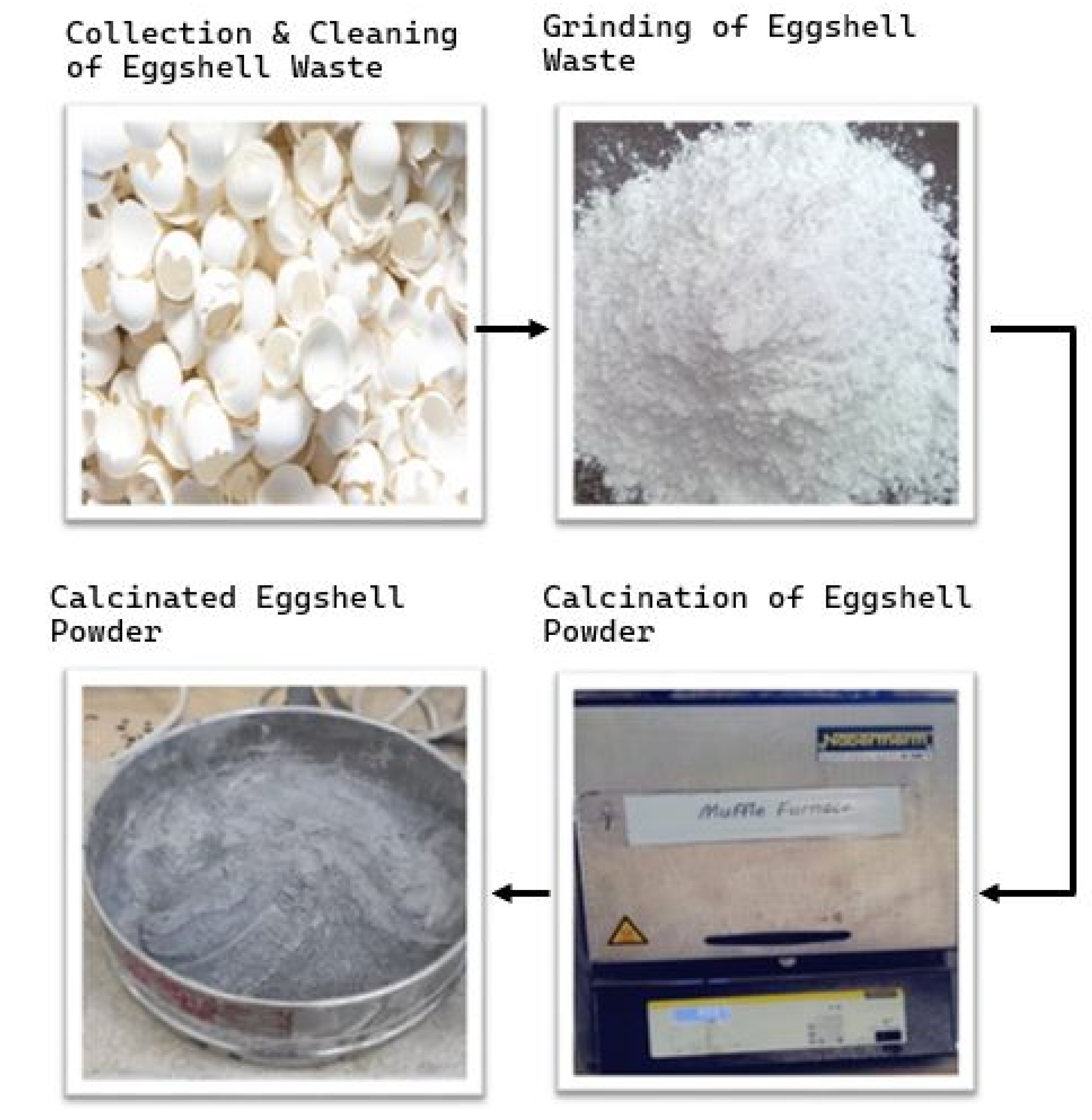

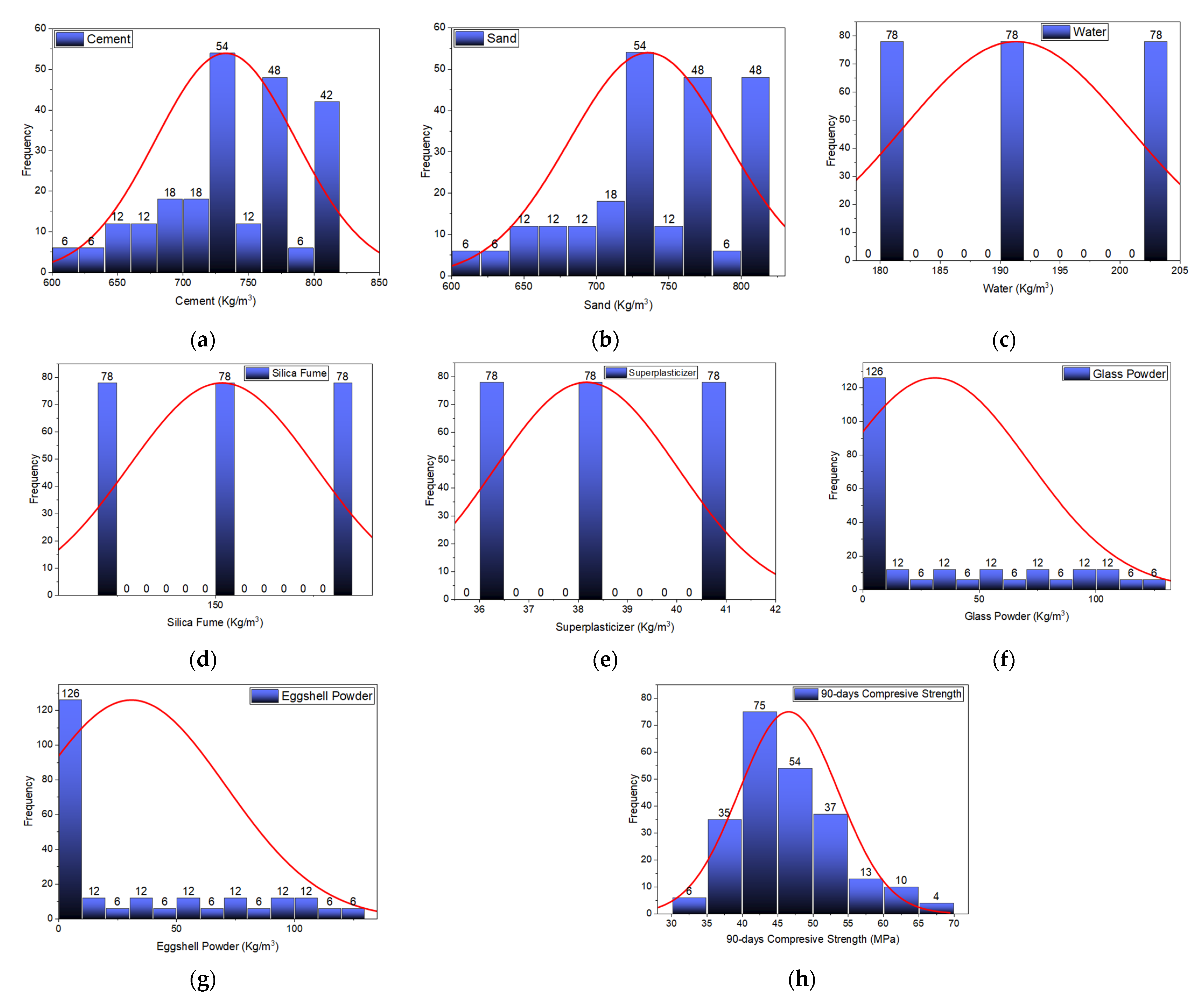
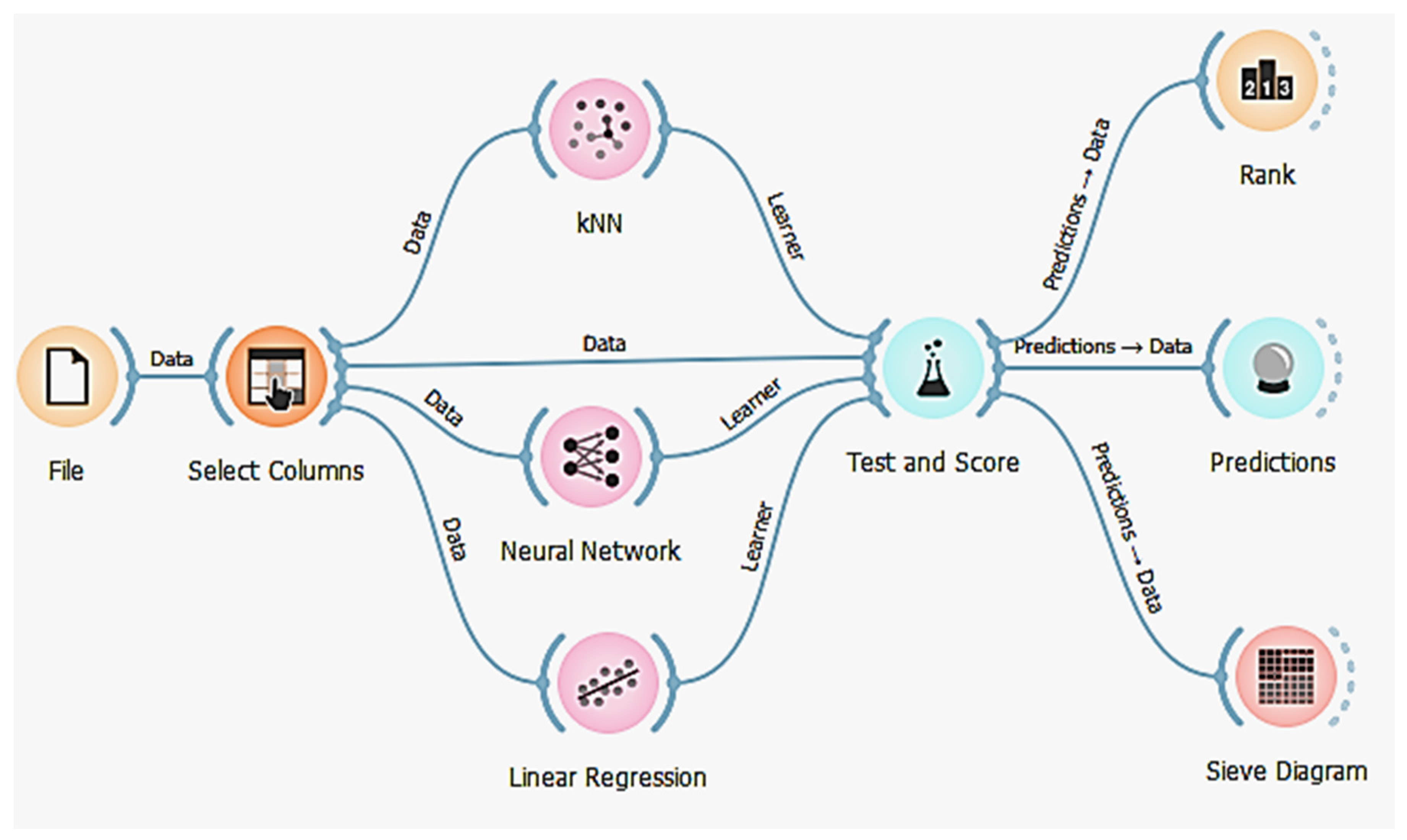

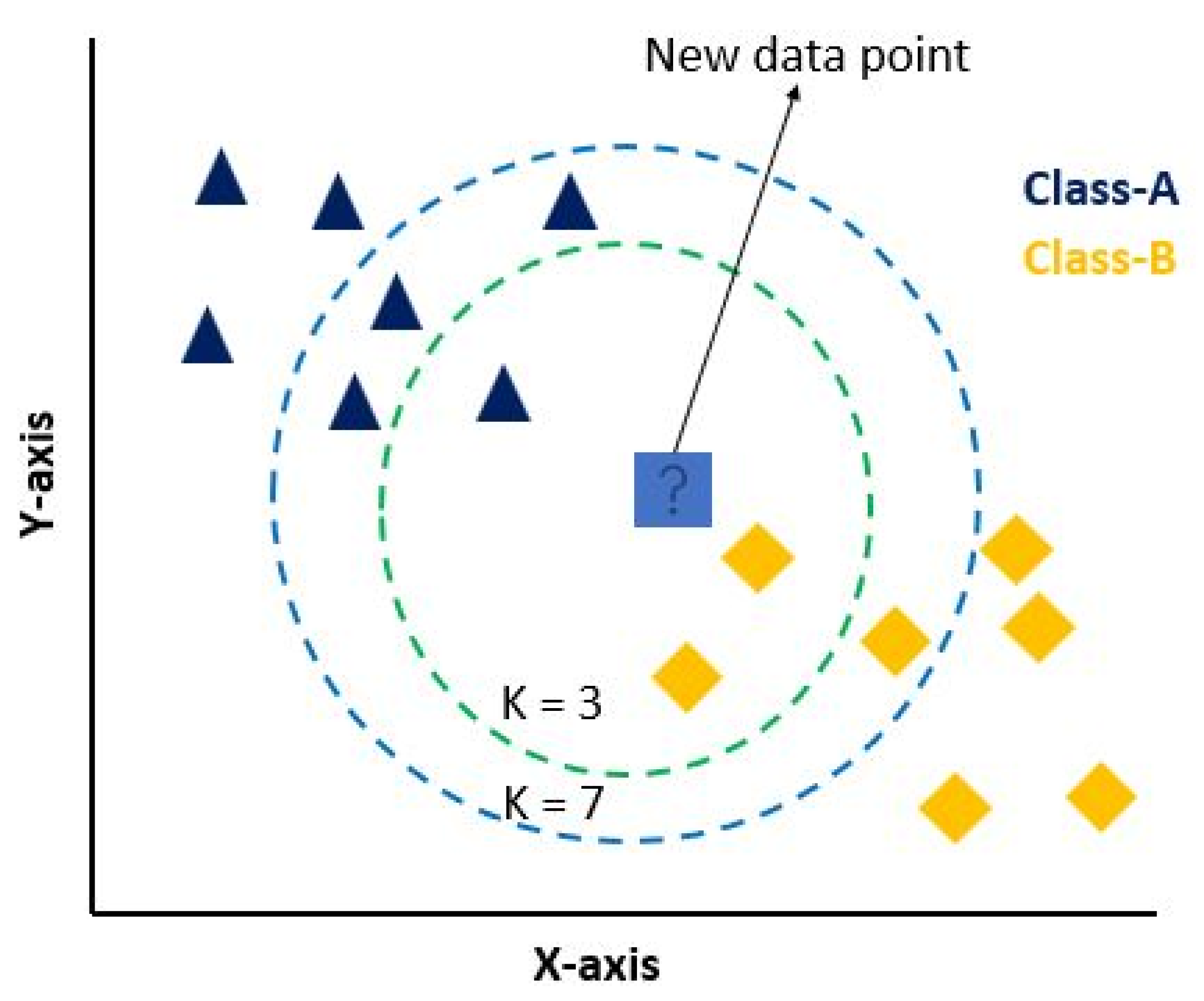
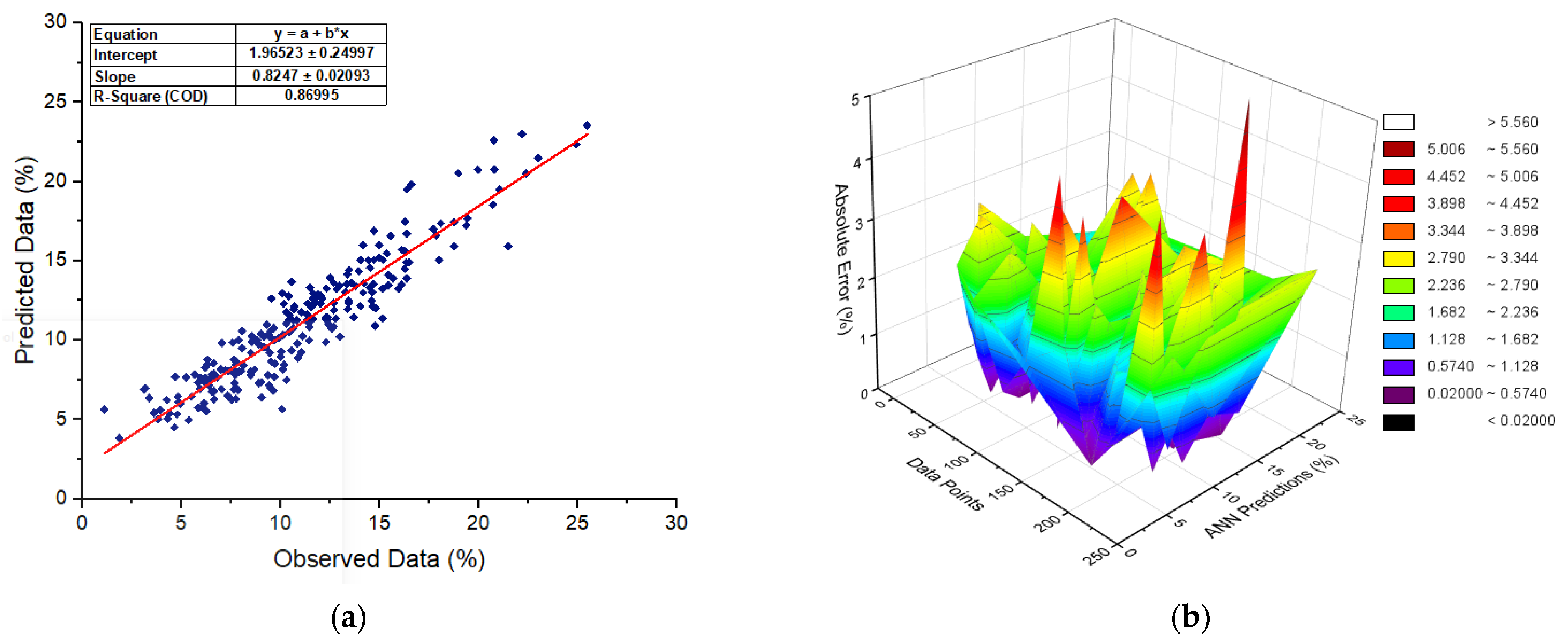

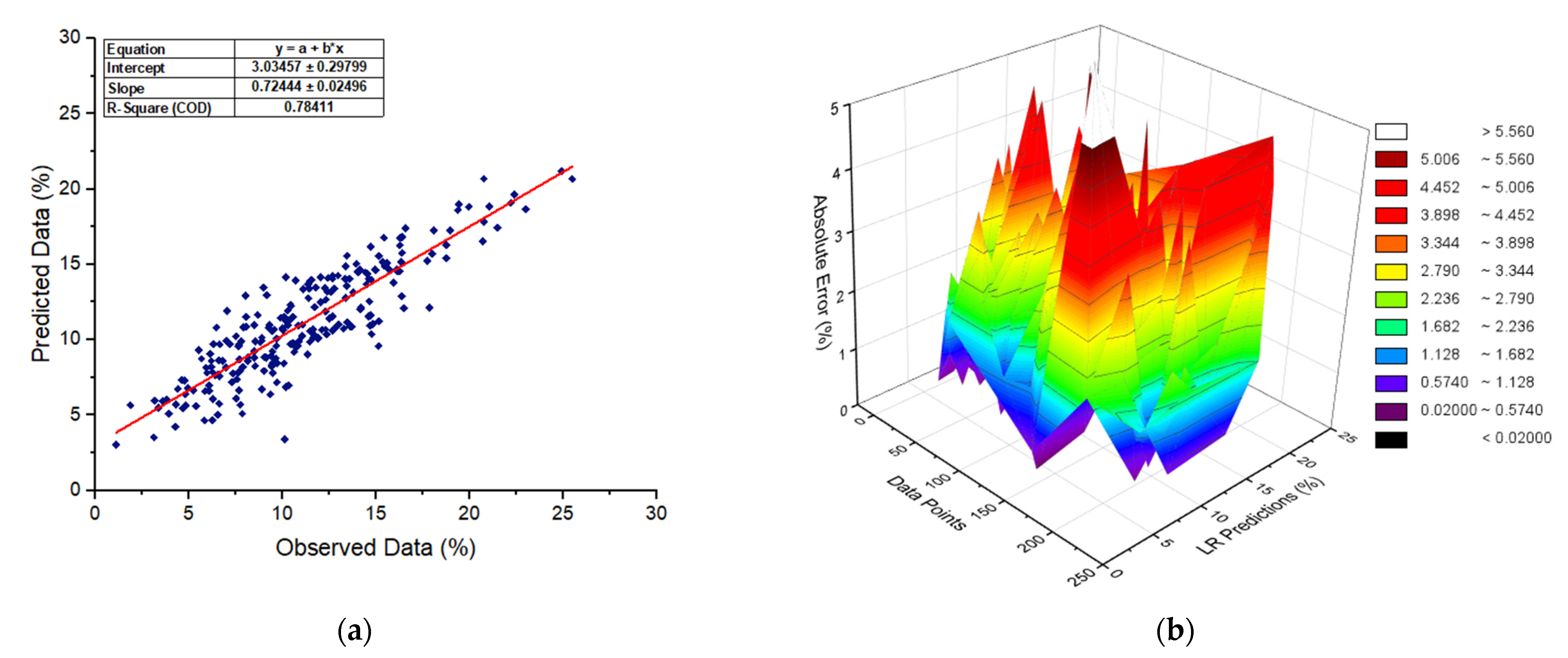
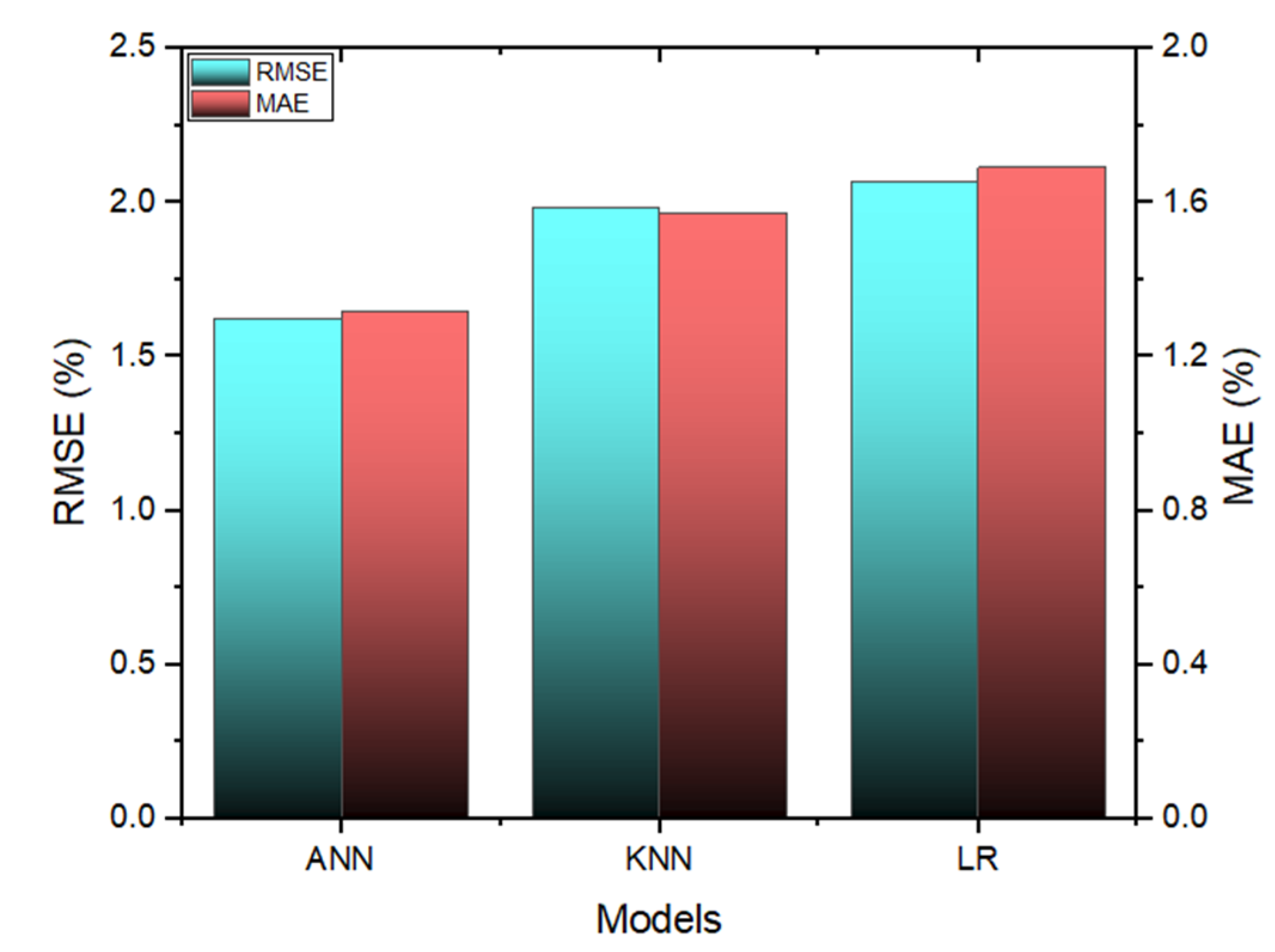
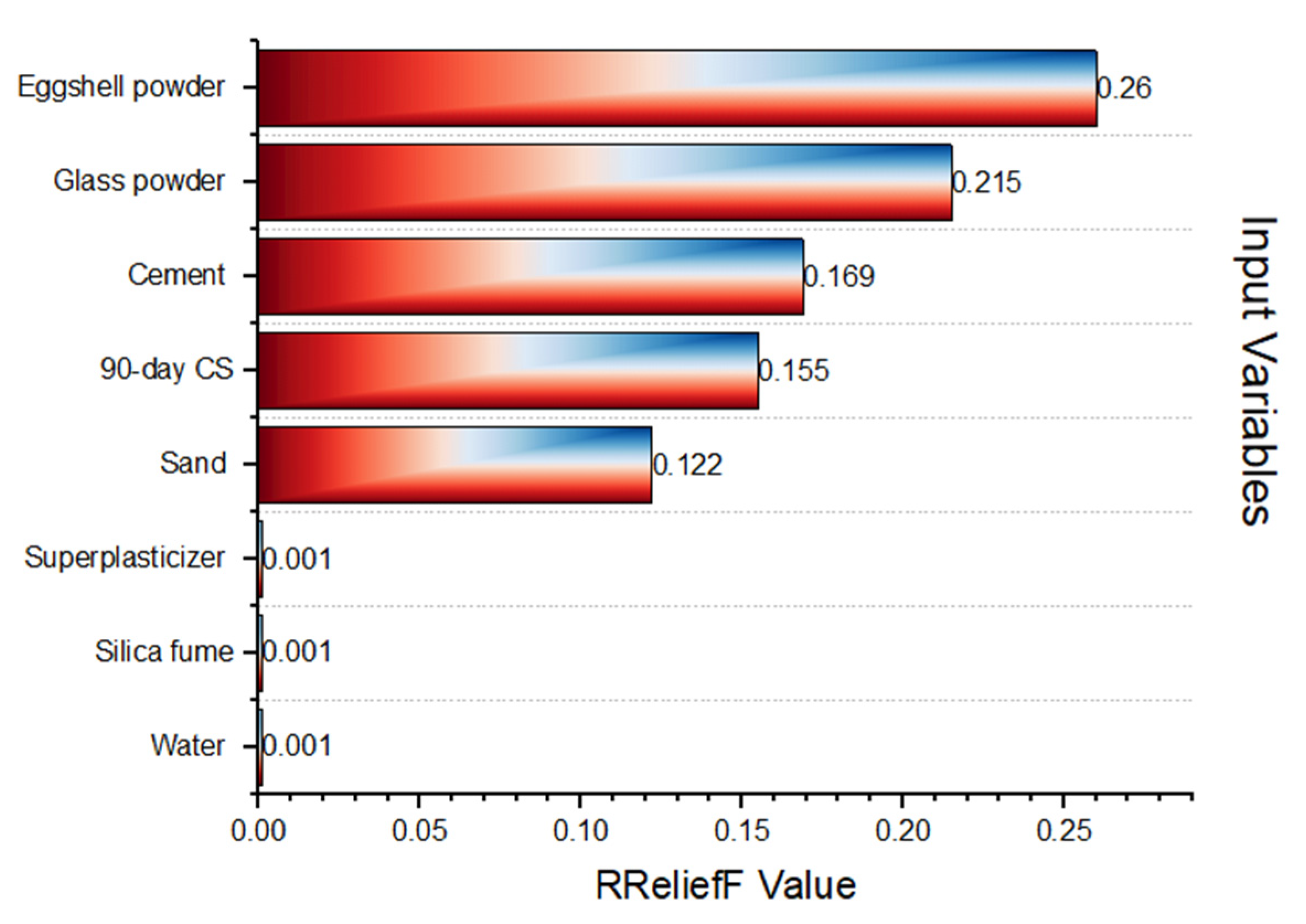

| Parameters | Cement | Sand | Water | Silica Fume | Superplasticizer | Glass Powder | Eggshell Powder | 90-Day CS |
|---|---|---|---|---|---|---|---|---|
| Units | kg/m3 | kg/m3 | kg/m3 | kg/m3 | kg/m3 | kg/m3 | kg/m3 | MPa |
| Mean | 732.51 | 735.62 | 191.33 | 151.67 | 38.17 | 30.83 | 30.83 | 46.56 |
| Median | 722.00 | 729.00 | 191.00 | 153.00 | 38.00 | 0.00 | 0.00 | 45.17 |
| Mode | 810.00 | 810.00 | 203.00 | 122.00 | 40.50 | 0.00 | 0.00 | 41.93 |
| Standard Deviation | 53.51 | 54.39 | 9.41 | 23.75 | 1.84 | 40.15 | 40.15 | 7.02 |
| Kurtosis | −0.61 | −0.61 | −1.51 | −1.51 | −1.51 | −0.61 | −0.61 | 0.22 |
| Skewness | −0.24 | −0.32 | 0.05 | −0.08 | 0.14 | 0.93 | 0.93 | 0.70 |
| Minimum | 612.00 | 612.00 | 180.00 | 122.00 | 36.00 | 0.00 | 0.00 | 32.32 |
| Maximum | 810.00 | 810.00 | 203.00 | 180.00 | 40.50 | 121.50 | 121.50 | 66.92 |
| Count | 234.00 | 234.00 | 234.00 | 234.00 | 234.00 | 234.00 | 234.00 | 234.00 |
| Parameter | Assigned Function |
|---|---|
| Neurons in hidden layers | 500 |
| Activation | ReLu |
| Solver | SGD |
| Regularization (α) | 0.0001 |
| Maximal no of iteration | 1000 |
| Replicable training | yes |
| Parameter | Assigned Function |
|---|---|
| No of neighbors | 8 |
| Distance matrix | Chebyshev |
| Weight | Uniform |
| Errors (%) | ANN | KNN | LR |
|---|---|---|---|
| R2 | 0.87 | 0.81 | 0.78 |
| MSE | 5.61 | 7.17 | 9.39 |
| RMSE | 1.63 | 1.98 | 2.07 |
| MAE | 1.32 | 1.57 | 1.69 |
| Materials | Properties | Models | Outperformed Model | Reference |
|---|---|---|---|---|
| Self-healing concrete | CS | ANN, ANFIS | ANN | [80] |
| Alkali-activated materials | CS | KNN, ANN, DT | ANN | [61] |
| GGBFS-based concrete | CS | LR, ANN, non-LR, quadratic, full quadratic models | ANN | [81] |
| Concrete with hooked steel fibers | CS | KNN, ANN | ANN | [82] |
| Concrete bricks utilizing various industrial wastes like fly ash, rise husk ash, and hydrated lime | Water absorption, CS, Density | Multiple LR, ANN | ANN | [83] |
| RGP-based concrete | CS | ANN, LR, non-LR | ANN | [79] |
Disclaimer/Publisher’s Note: The statements, opinions and data contained in all publications are solely those of the individual author(s) and contributor(s) and not of MDPI and/or the editor(s). MDPI and/or the editor(s) disclaim responsibility for any injury to people or property resulting from any ideas, methods, instructions or products referred to in the content. |
© 2024 by the authors. Licensee MDPI, Basel, Switzerland. This article is an open access article distributed under the terms and conditions of the Creative Commons Attribution (CC BY) license (https://creativecommons.org/licenses/by/4.0/).
Share and Cite
Zhu, F.; Wu, X.; Lu, Y.; Huang, J. Strength Reduction Due to Acid Attack in Cement Mortar Containing Waste Eggshell and Glass: A Machine Learning-Based Modeling Study. Buildings 2024, 14, 225. https://doi.org/10.3390/buildings14010225
Zhu F, Wu X, Lu Y, Huang J. Strength Reduction Due to Acid Attack in Cement Mortar Containing Waste Eggshell and Glass: A Machine Learning-Based Modeling Study. Buildings. 2024; 14(1):225. https://doi.org/10.3390/buildings14010225
Chicago/Turabian StyleZhu, Fei, Xiangping Wu, Yijun Lu, and Jiandong Huang. 2024. "Strength Reduction Due to Acid Attack in Cement Mortar Containing Waste Eggshell and Glass: A Machine Learning-Based Modeling Study" Buildings 14, no. 1: 225. https://doi.org/10.3390/buildings14010225
APA StyleZhu, F., Wu, X., Lu, Y., & Huang, J. (2024). Strength Reduction Due to Acid Attack in Cement Mortar Containing Waste Eggshell and Glass: A Machine Learning-Based Modeling Study. Buildings, 14(1), 225. https://doi.org/10.3390/buildings14010225






